2017 NISSAN ALTIMA ignition
[x] Cancel search: ignitionPage 6 of 36
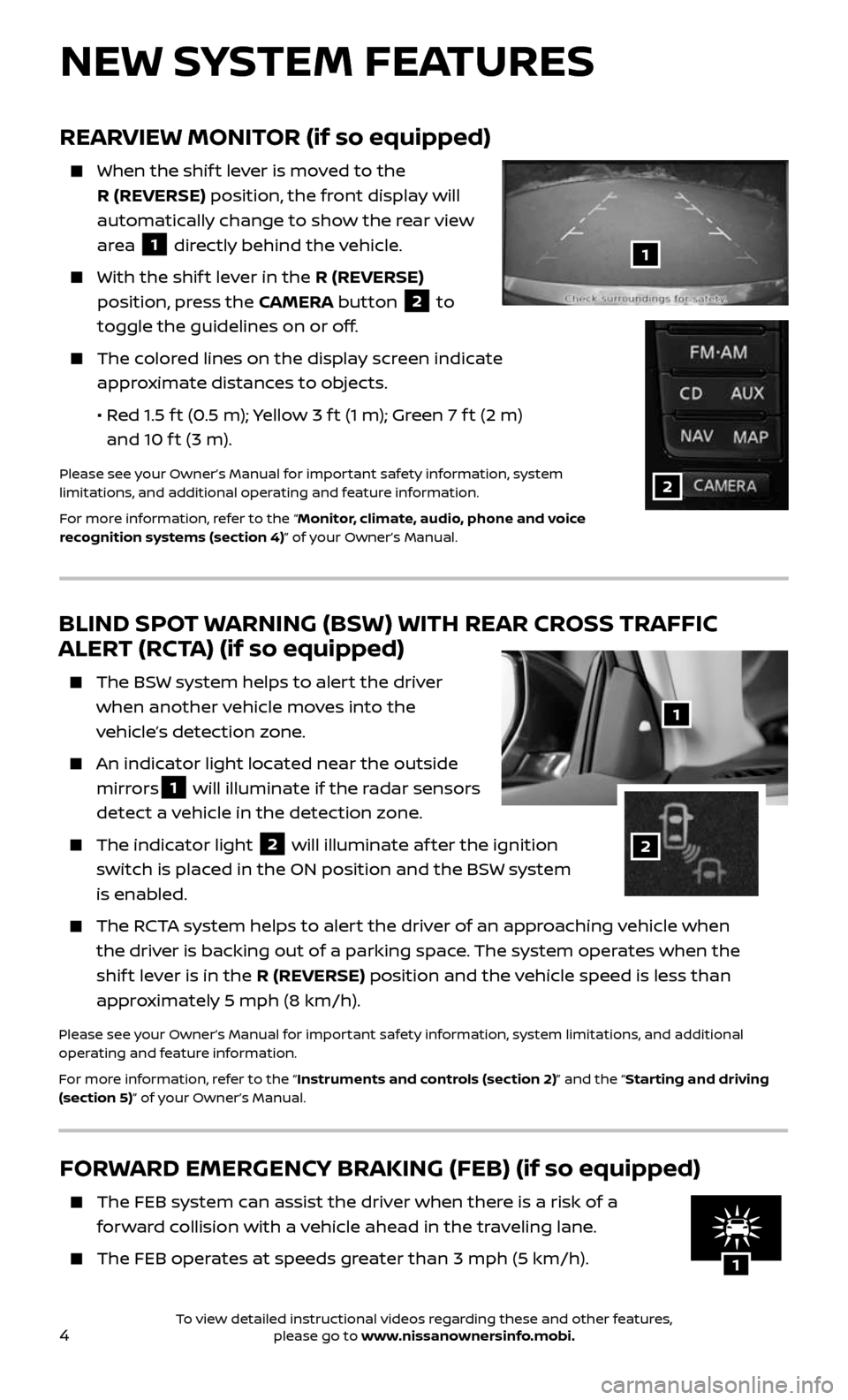
4
FORWARD EMERGENCY BRAKING (FEB) (if so equipped)
The FEB system can assist the driver when there is a risk of a
forward collision with a vehicle ahead in the traveling lane.
The FEB operates at speeds greater than 3 mph (5 km/h).
NEW SYSTEM FEATURES
REARVIEW MONITOR (if so equipped)
When the shif t lever is moved to the
R (REVERSE) position, the front display will
automatically change to show the rear view
area
1 directly behind the vehicle.
With the shif t lever in the R (REVERSE)
position, press the CAMERA button
2 to
toggle the guidelines on or off.
The colored lines on the display screen indicate
approximate distances to objects.
• Red 1.5 f t (0.5 m); Yellow 3 f t (1 m); Green 7 f t (2 m)
and 10 f t (3 m).
Please see your Owner’s Manual for important safety information, system
limitations, and additional operating and feature information.
For more information, refer to the “Monitor, climate, audio, phone and voice
recognition systems (section 4)” of your Owner’s Manual.
1
2
BLIND SPOT WARNING (BSW) WITH REAR CROSS TRAFFIC
ALERT (RCTA) (if so equipped)
The BSW system helps to alert the driver
when another vehicle moves into the
vehicle’s detection zone.
An indicator light located near the outside
mirrors1 will illuminate if the radar sensors
detect a vehicle in the detection zone.
The indic ator light 2 will illuminate af ter the ignition
switch is placed in the ON position and the BSW system
is enabled.
The RCTA system helps to alert the driver of an approaching vehicle when
the driver is backing out of a parking space. The system operates when the
shif t lever is in the R (REVERSE) position and the vehicle speed is less than
approximately 5 mph (8 km/h).
Please see your Owner’s Manual for important safety information, system limitations, and additional
operating and feature information.
For more information, refer to the “Instruments and controls (section 2)” and the “Starting and driving
(section 5)” of your Owner’s Manual.
1
2
2 11
To view detailed instructional videos regarding these and other features, please go to www.nissanownersinfo.mobi.
Page 9 of 36
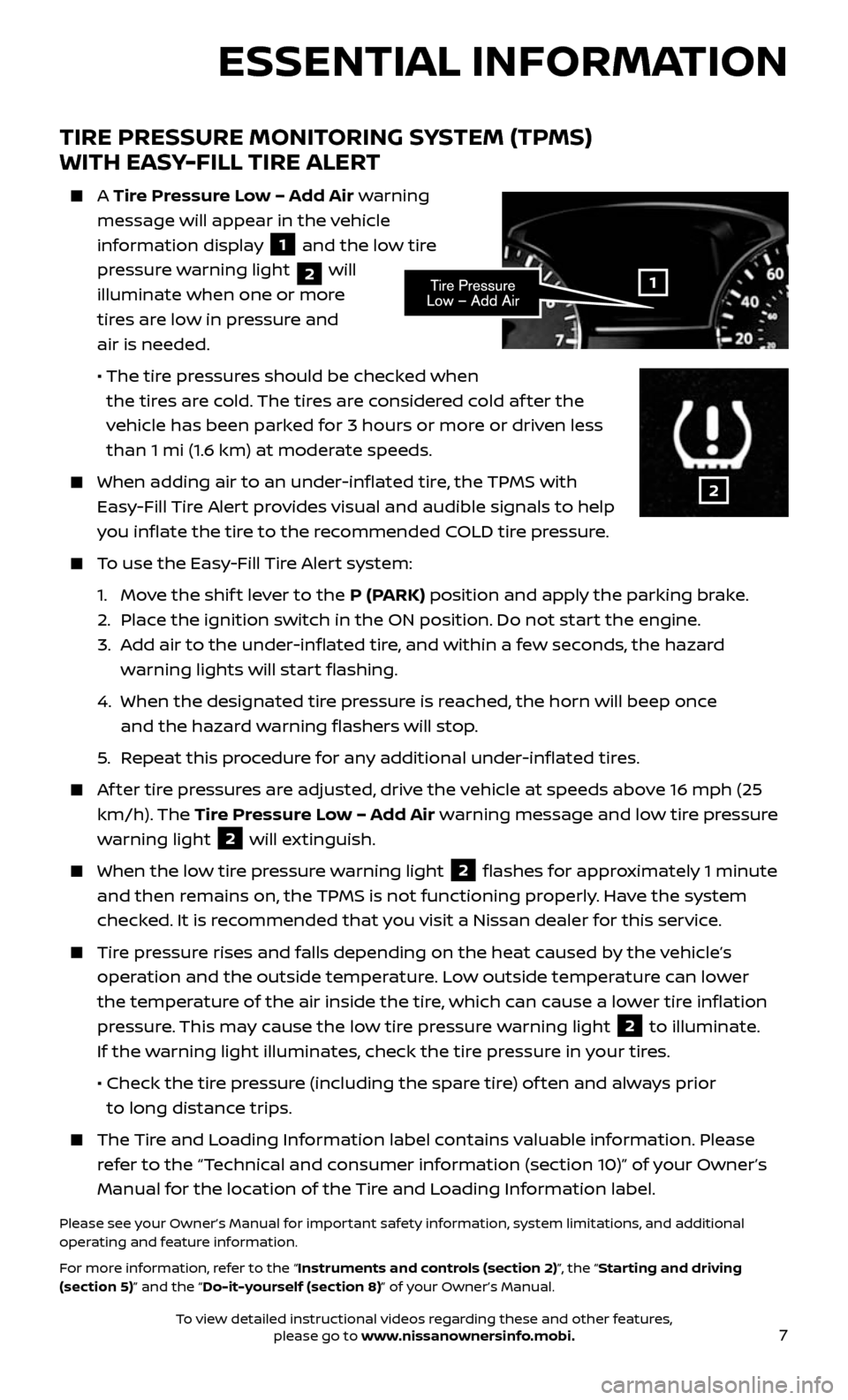
7
ESSENTIAL INFORMATION
TIRE PRESSURE MONITORING SYSTEM (TPMS)
WITH EASY-FILL TIRE ALERT
A Tire Pressure Low – Add Air warning
message will appear in the vehicle
information display
1 and the low tire
pressure warning light
2 will
illuminate when one or more
tires are low in pressure and
air is needed.
• The tir e pressures should be checked when
the tires are cold. The tires are considered cold af ter the
vehicle has been parked for 3 hours or more or driven less
than 1 mi (1.6 km) at moderate speeds.
When adding air to an under -inflated tire, the TPMS with
Easy-Fill Tire Alert provides visual and audible signals to help
you inflate the tire to the recommended COLD tire pressure.
To use the Easy-Fill Tire Alert system:
1. Move the shif t lever to the P (PARK) position and apply the parking brake.
2. Place the ignition switch in the ON position. Do not start the engine.
3. Add air to the under-inflated tire, and within a few seconds, the hazard
warning lights will start flashing.
4. When the designated tir e pressure is reached, the horn will beep once
and the hazard warning flashers will stop.
5. Repeat this procedure for any additional under-inflated tires.
Af ter tire pressures are adjusted, drive the vehicle at speeds above 16 mph (25
km/h). The Tire Pressure Low – Add Air warning message and low tire pressure
warning light
2 will extinguish.
When the lo w tire pressure warning light 2 flashes for approximately 1 minute
and then remains on, the TPMS is not functioning properly. Have the system
checked. It is recommended that you visit a Nissan dealer for this service.
Tire pressure rises and falls depending on the heat caused by the vehicle’s
operation and the outside temperature. Low outside temperature can lower
the temperature of the air inside the tire, which can cause a lower tire inflation
pressure. This may cause the low tire pressure warning light
2 to illuminate.
If the warning light illuminates, check the tire pressure in your tires.
• Check the tir e pressure (including the spare tire) of ten and always prior
to long distance trips.
The Tire and Loading Information label contains valuable information. Please
refer to the “Technical and consumer information (section 10)” of your Owner’s
Manual for the location of the Tire and Loading Information label.
Please see your Owner’s Manual for important safety information, system limitations, and additional
operating and feature information.
For more information, refer to the “Instruments and controls (section 2)”, the “Starting and driving
(section 5)” and the “Do-it-yourself (section 8)” of your Owner’s Manual.
1
2
To view detailed instructional videos regarding these and other features, please go to www.nissanownersinfo.mobi.
Page 12 of 36
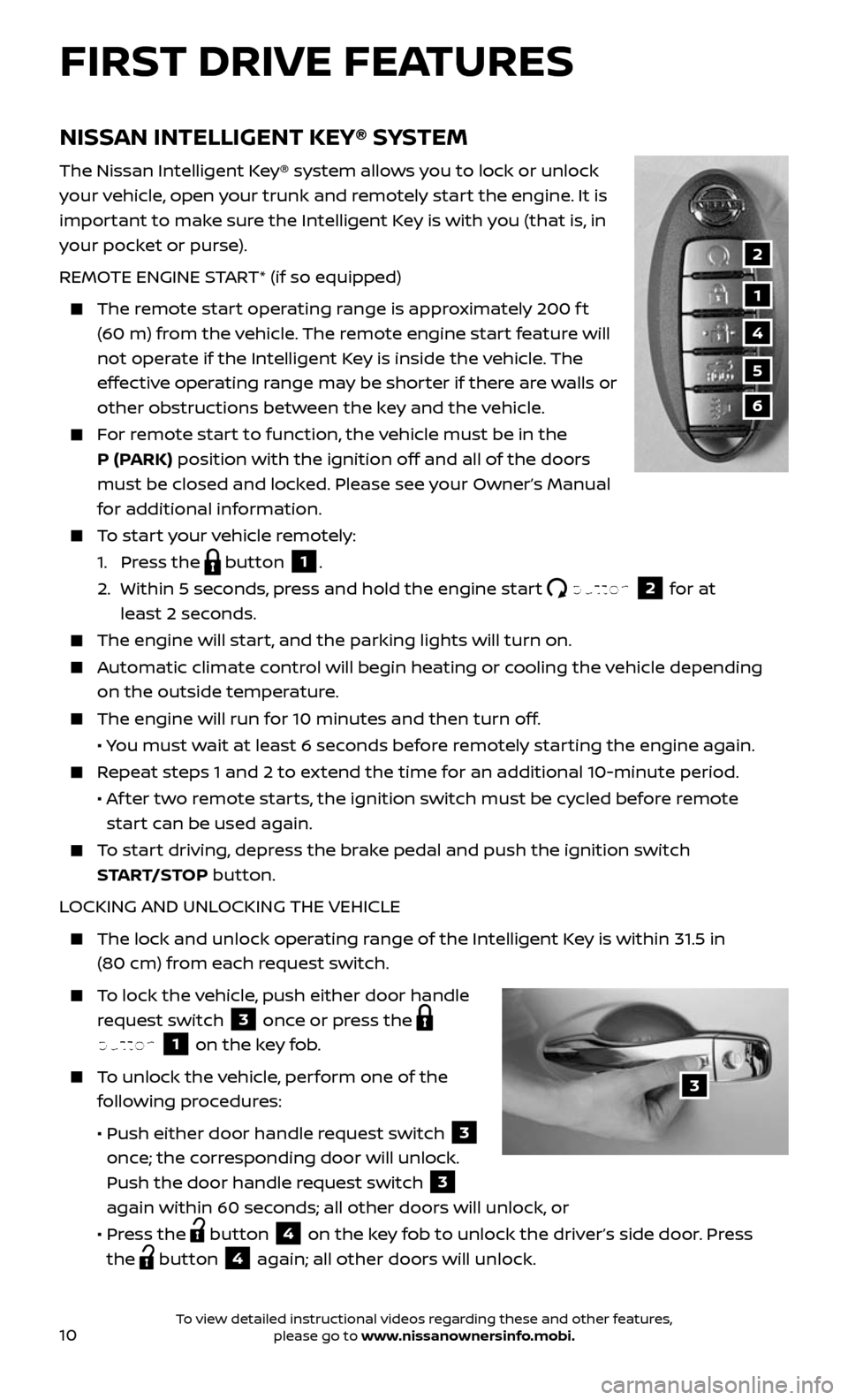
10
NISSAN INTELLIGENT KEY® SYSTEM
The Nissan Intelligent Key® system allows you to lock or unlock
your vehicle, open your trunk and remotely start the engine. It is
important to make sure the Intelligent Key is with you (that is, in
your pocket or purse).
REMOTE ENGINE START* (if so equipped)
The remote start operating range is approximately 200 f t
(60 m) from the vehicle. The remote engine start feature will
not operate if the Intelligent Key is inside the vehicle. The
effective operating range may be shorter if there are walls or
other obstructions between the key and the vehicle.
For remote start to function, the vehicle must be in the
P (PARK) position with the ignition off and all of the doors
must be closed and locked. Please see your Owner’s Manual
for additional information.
To start your vehicle remotely:
1. Press the button 1.
2. Within 5 sec onds, press and hold the engine start button 2 for at
least 2 seconds.
The engine wil l start, and the parking lights will turn on.
Automatic climate control will begin heating or cooling the vehicle depending
on the outside temperature.
The engine will run for 10 minutes and then turn off.
• You must wait at least 6 seconds before remotely starting the engine again.
Repeat steps 1 and 2 to extend the time for an additional 10-minute period.
• Af ter two remote starts, the ignition switch must be cycled before remote
start can be used again.
To start driving, depress the brake pedal and push the ignition switch
START/STOP button.
LOCKING AND UNLOCKING THE VEHICLE
The lock and unlock oper ating range of the Intelligent Key is within 31.5 in
(80 cm) from each request switch.
To lock the vehicle, push either door handle
request switch 3 once or press the
button 1 on the key fob.
To unlock the vehicle, perform one of the
following procedures:
• Push either door hand le request switch 3
once; the corresponding door will unlock.
Push the door handle request switch
3
again within 60 seconds; all other doors will unlock, or
• Press the button 4 on the key fob to unlock the driver’s side door. Press
the
button 4 again; all other doors will unlock.
1
2
4
5
6
3
FIRST DRIVE FEATURES
To view detailed instructional videos regarding these and other features, please go to www.nissanownersinfo.mobi.
Page 13 of 36
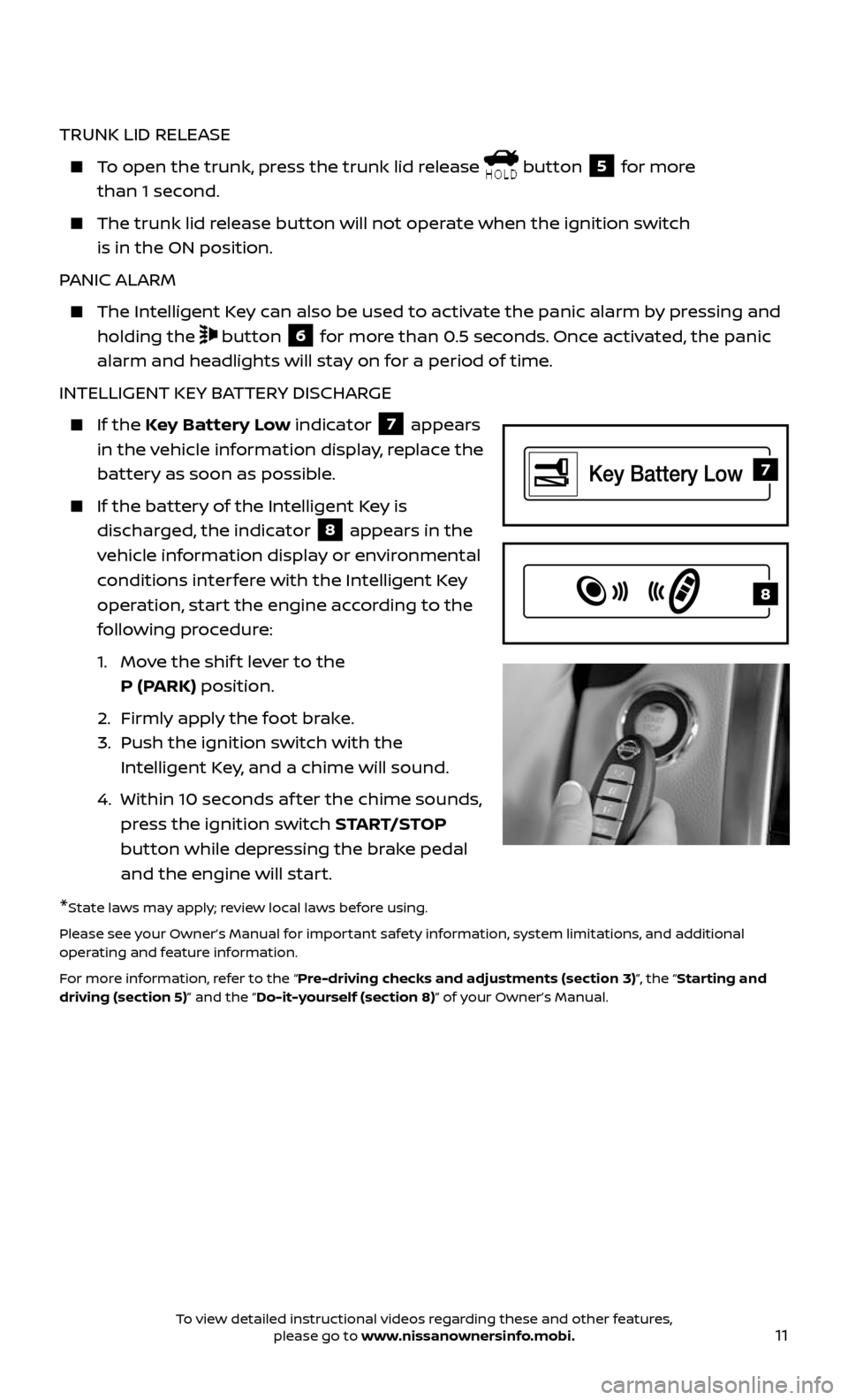
11
TRUNK LID RELEASE
To open the trunk, press the trunk lid release button 5 for more
than 1 second.
The trunk lid r elease button will not operate when the ignition switch
is in the ON position.
PANIC ALARM
The Intel ligent Key can also be used to activate the panic alarm by pressing and
holding the button 6 for more than 0.5 seconds. Once activated, the panic
alarm and headlights will stay on for a period of time.
INTELLIGENT KEY BATTERY DISCHARGE
If the Key Battery Low indicator 7 appears
in the vehicle information display, replace the
battery as soon as possible.
If the bat tery of the Intelligent Key is
discharged, the indicator 8 appears in the
vehicle information display or environmental
conditions interfere with the Intelligent Key
operation, start the engine according to the
following procedure:
1. Move the shif t lever to the
P (PARK) position.
2. Firml y apply the foot brake.
3. Push the ignition switch with the
Intelligent Key, and a chime will sound.
4. Within 10 sec onds af ter the chime sounds,
press the ignition switch START/STOP
button while depressing the brake pedal
and the engine will start.
*State laws may apply; review local laws before using.
Please see your Owner’s Manual for important safety information, system limitations, and additional
operating and feature information.
For more information, refer to the “Pre-driving checks and adjustments (section 3)”, the “Starting and
driving (section 5)” and the “Do-it-yourself (section 8)” of your Owner’s Manual.
7
8
To view detailed instructional videos regarding these and other features, please go to www.nissanownersinfo.mobi.
Page 15 of 36
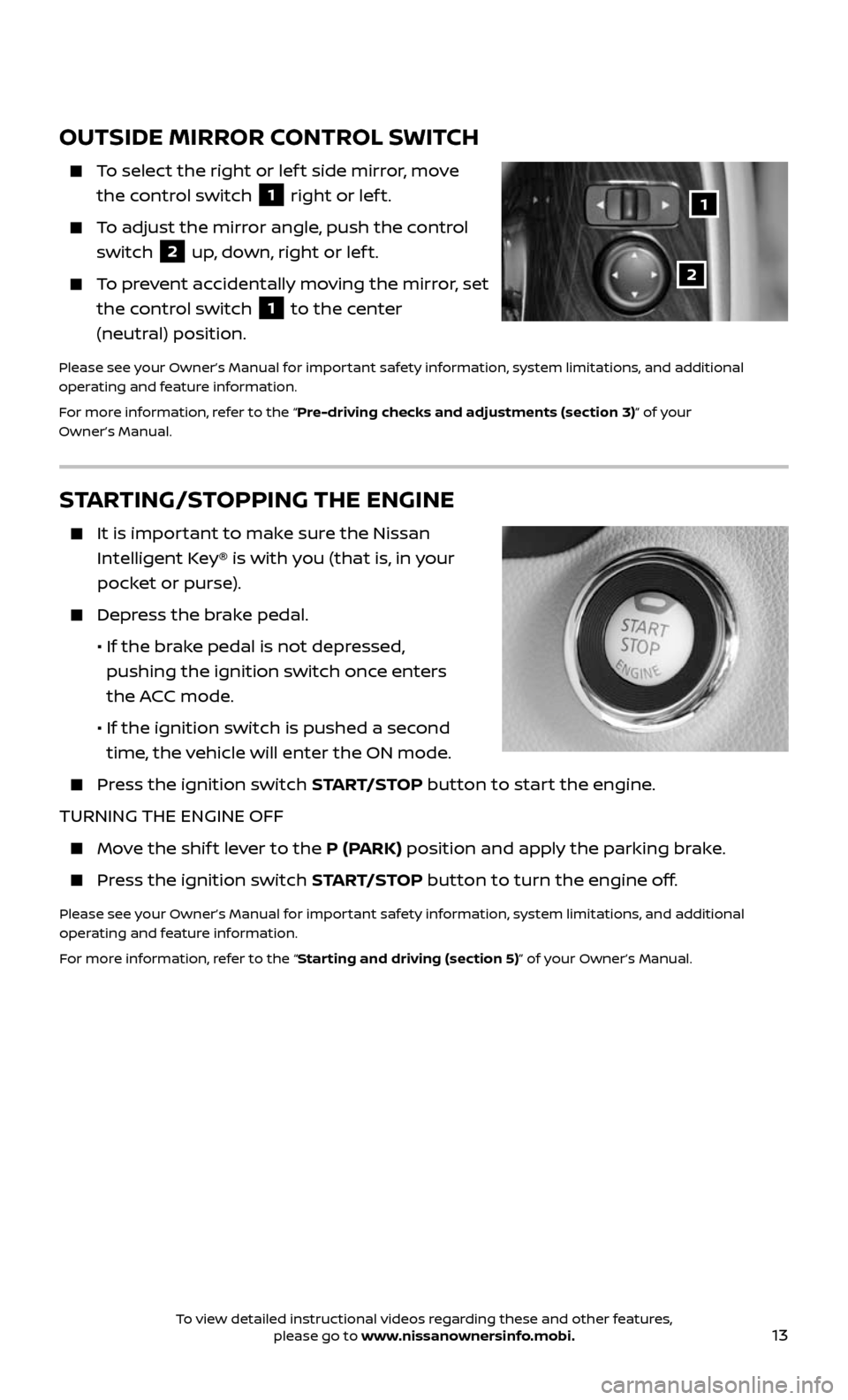
13
OUTSIDE MIRROR CONTROL SWITCH
To select the right or lef t side mirror, move
the control switch 1 right or lef t.
To adjust the mirror angle, push the control
switch 2 up, down, right or lef t.
To prevent accidentally moving the mirror, set
the control switch 1 to the center
(neutral) position.
Please see your Owner’s Manual for important safety information, system limitations, and additional
operating and feature information.
For more information, refer to the “Pre-driving checks and adjustments (section 3)” of your
Owner’s Manual.
2
1
STARTING/STOPPING THE ENGINE
It is impor tant to make sure the Nissan
Intelligent Key® is with you (that is, in your
pocket or purse).
Depress the brake pedal.
• If the br ake pedal is not depressed,
pushing the ignition switch once enters
the ACC mode.
• If the ignition switch is pushed a sec ond
time, the vehicle will enter the ON mode.
Press the ignition switch START/STOP button to start the engine.
TURNING THE ENGINE OFF
Move the shif t lever to the P (PARK) position and apply the parking brake.
Press the ignition switch START/STOP button to turn the engine off.
Please see your Owner’s Manual for important safety information, system limitations, and additional
operating and feature information.
For more information, refer to the “Starting and driving (section 5)” of your Owner’s Manual.
To view detailed instructional videos regarding these and other features, please go to www.nissanownersinfo.mobi.
Page 16 of 36
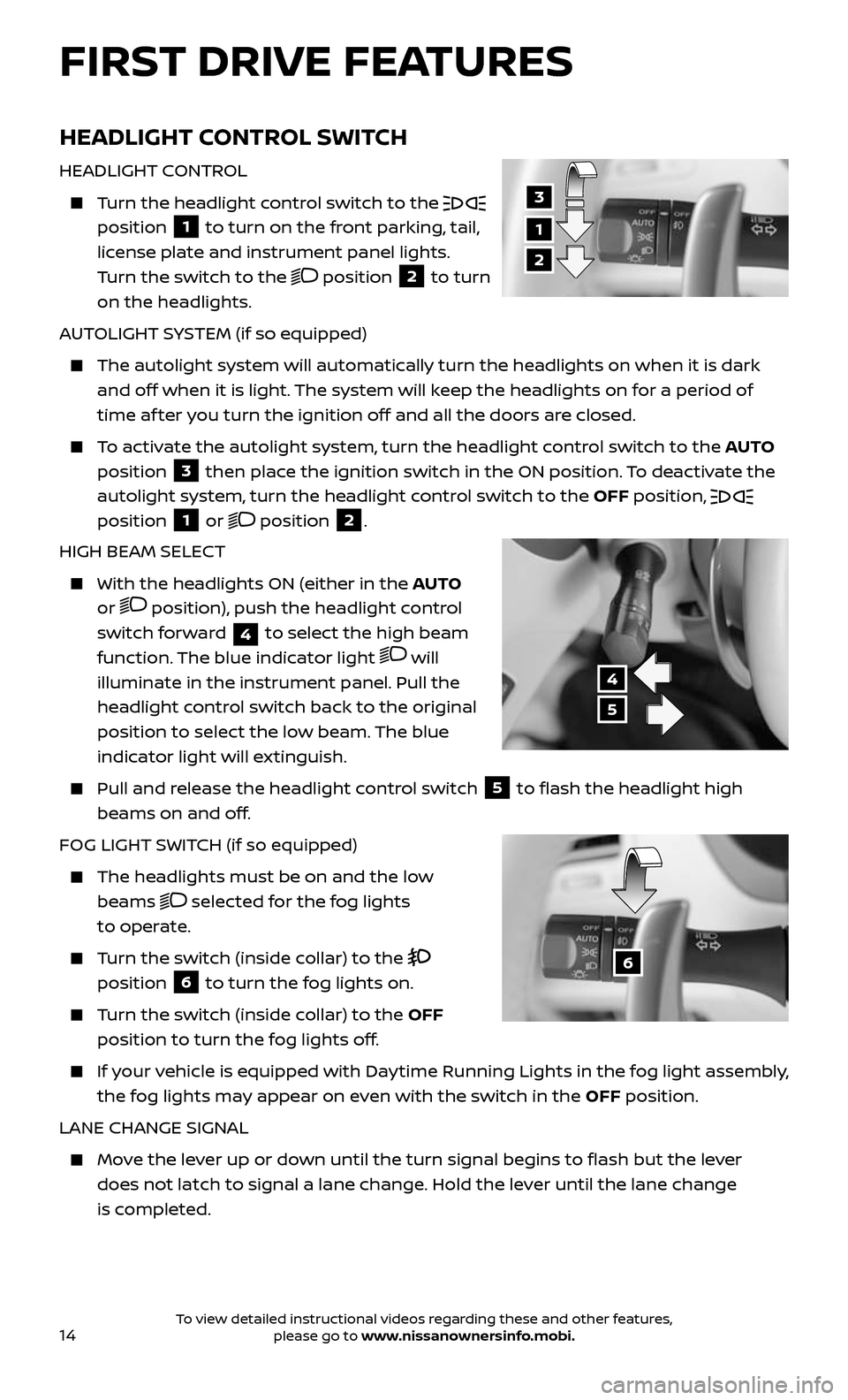
14
HEADLIGHT CONTROL SWITCH
HEADLIGHT CONTROL
Turn the headlight control switch to the position 1 to turn on the front parking, tail,
license plate and instrument panel lights.
Turn the switch to the
position 2 to turn
on the headlights.
AUTOLIGHT SYSTEM (if so equipped)
The autolight system wil l automatically turn the headlights on when it is dark
and off when it is light. The system will keep the headlights on for a period of
time af ter you turn the ignition off and all the doors are closed.
To activate the autolight system, turn the headlight control switch to the AUTO
position
3 then place the ignition switch in the ON position. To deactivate the
autolight system, turn the headlight control switch to the OFF position,
position 1 or position 2.
HIGH BEAM SELECT
With the he adlights ON (either in the AUTO
or
position), push the headlight control
switch forward 4 to select the high beam
function. The blue indicator light
will
illuminate in the instrument panel. Pull the
headlight control switch back to the original
position to select the low beam. The blue
indicator light will extinguish.
Pull and release the headlight control switch 5 to flash the headlight high
beams on and off.
FOG LIGHT SWITCH (if so equipped)
The headlights must be on and the low
beams selected for the fog lights
to operate.
Turn the switch (inside collar) to the
position 6 to turn the fog lights on.
Turn the switch (inside collar) to the OFF
position to turn the fog lights off.
If your vehicle is equipped with Daytime Running Lights in the fog light assembly,
the fog lights may appear on even with the switch in the OFF position.
LANE CHANGE SIGNAL
Move the lever up or down until the turn signal begins to flash but the lever
does not latch to signal a lane change. Hold the lever until the lane change
is completed.
6
FIRST DRIVE FEATURES
1
3
2
4
5
To view detailed instructional videos regarding these and other features, please go to www.nissanownersinfo.mobi.
Page 23 of 36
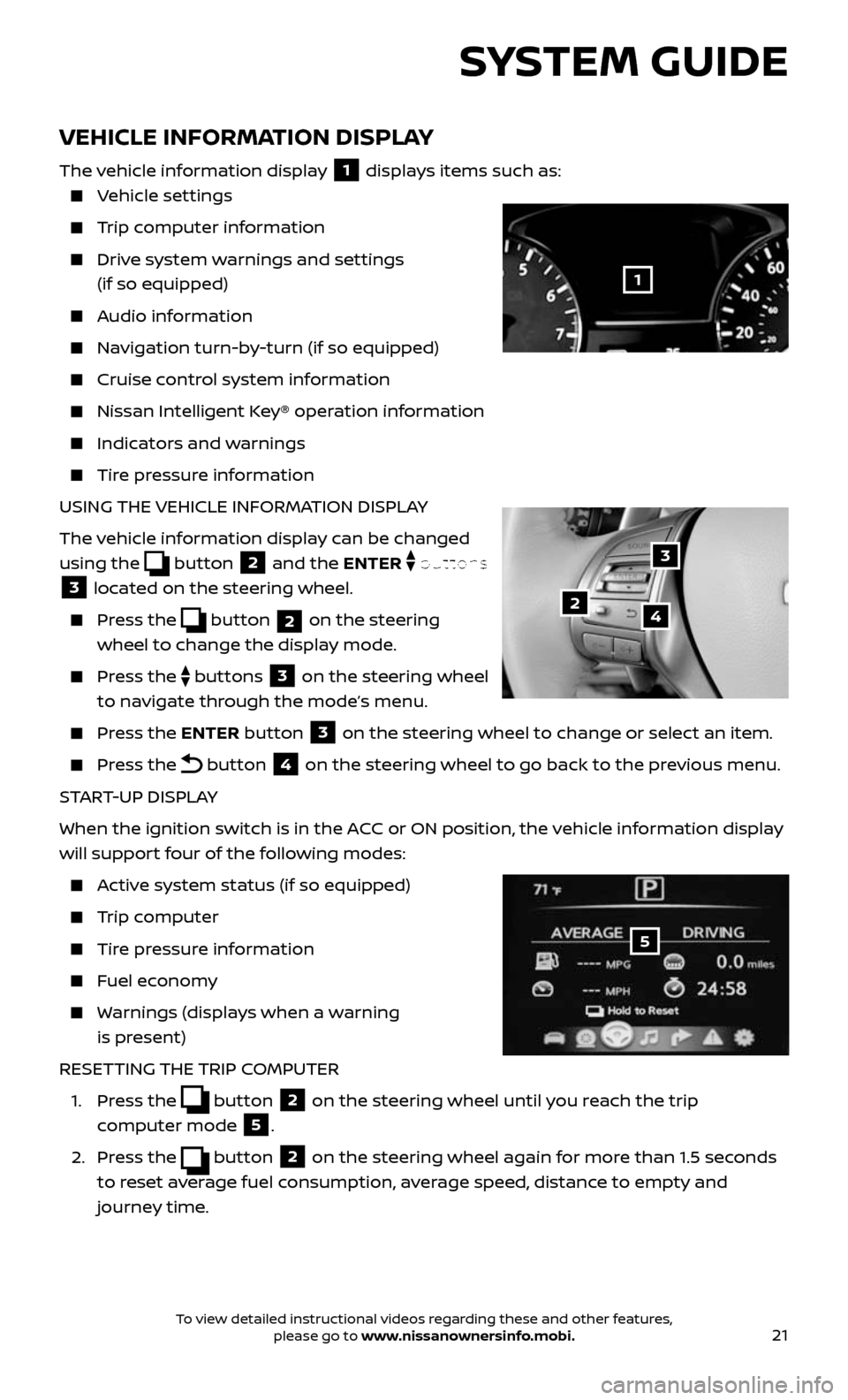
21
VEHICLE INFORMATION DISPLAY
The vehicle information display 1 displays items such as:
Vehicle settings
Trip computer information
Drive system warnings and settings
(if so equipped)
Audio information
Navigation turn-by-turn (if so equipped)
Cruise control system information
Nissan Intel ligent Key® operation information
Indicators and warnings
Tire pressure information
USING THE VEHICLE INFORMATION DISPLAY
The vehicle information display can be changed
using the
button 2 and the ENTER buttons
3 located on the steering wheel.
Press the button 2 on the steering
wheel to change the display mode.
Press the buttons 3 on the steering wheel
to navigate through the mode’s menu.
Press the ENTER button 3 on the steering wheel to change or select an item.
Press the button 4 on the steering wheel to go back to the previous menu.
START-UP DISPLAY
When the ignition switch is in the ACC or ON position, the vehicle information display
will support four of the following modes:
Active system status (if so equipped)
Trip computer
Tire pressure information
Fuel economy
Warnings (displays when a warning
is present)
RESETTING THE TRIP COMPUTER
1. Press the button 2 on the steering wheel until you reach the trip
computer mode
5.
2. Press the button 2 on the steering wheel again for more than 1.5 seconds
to reset average fuel consumption, average speed, distance to empty and
journey time.
3
42
5
SYSTEM GUIDE
1
To view detailed instructional videos regarding these and other features, please go to www.nissanownersinfo.mobi.